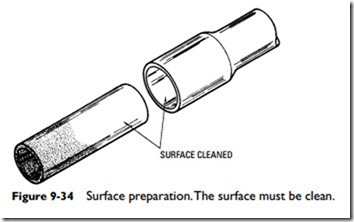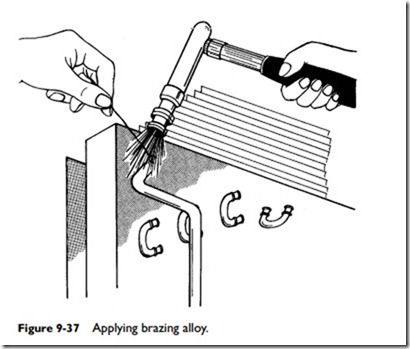Silver-Brazing Repairs
For the repair of tubing condensers, evaporators, and parts made of light metal, silver brazing is the ideal process. It was formerly known as silver soldering, a term still frequently used. The term silver soldering is used to avoid confusing the use of silver-brazing alloys with the soft solders. Some silver-brazing alloys contain a certain amount of silver alloyed with copper and zinc. Others con- tain silver, copper, and phosphors. These alloys are available in forms having melting temperatures ranging from 1175°F to 1500°F. The use of silver-brazing alloys enables the serviceperson to obtain strong joints without danger of burning or overheating the base metals. Apart from the skill acquired through practice, the two most important requirements of a good silver-brazing job are clean surfaces and enough heat to make the silver flow freely, but not so much that the silver burns to form scale. The best source of heat is
an oxyacetylene or compressed-air and illuminating gas torch.
The various operations to be performed in silver brazing are as follows:
1. Preparation
2. Preparing swaged joints
3. Preparing different-size tubing for connection
4. Applying the flux
5. Applying the brazing alloy
Silver brazing has very little tensile strength of its own. The total strength of the joint is derived from the union of the two surfaces as a result of the action of the alloys used. Accordingly, surfaces must fit together tightly.
The tubing should be expanded or swaged to a depth at least equal to its diameter for tubes up to 1⁄2 inch and not less than 1⁄2 inch deep for tubes of larger diameter. Special swaging blocks and drifts that accurately size and shape the inside of the tube and the outside of the expanded section are recommended for this operation where there is sufficient volume to warrant the investment. For occasional jobs, the tube can be held on a flare block and a swaging drift driven into it to form the bell end.
Where two tubes of different sizes, such as 3⁄8 inch and 1⁄2 inch, are to be joined, the smaller tube can be expanded by the previously described method until the outside diameter of the smaller tube is sized to fit snugly into the inside of the larger tube.
When the surfaces of the tube ends to be joined have been thoroughly cleaned with steel wool or sandpaper, they should be fitted together and clamped, or firmly held together so that no movement will occur while they are being brazed (see Figure 9-34).
Apply enough flux with a brush to cover the surfaces to be joined, but not so much that it will run down the tubing. Make certain, however, that the flux is inside the joint all the way around (see Figure 9-35).
After the flux has been applied, the heat should be concentrated on one side of the joint and the silver brazing applied (see Figures 9-36 and 9-37). The temperature of the parts to be joined should be high enough to melt the silver by touching it to the heated surfaces near the flame. When the silver melts, apply it to the heated surfaces near the flame, but not under the flame. Move the flame around the heated surface, following it with silver until silver has been applied to the entire joint. Do not use too much silver, and try to keep it from running down inside the tubing. Apply only enough heat to cause the silver-brazing alloy to flow freely in order to avoid the formation of scale or the burning of the surfaces.
Most of the heat should be applied to the heavier parts of the joint where it will be conducted through the metal to the location where the silver alloy is to be applied.
Flames should never be applied directly to the point where brazing is being done. For thorough inspection of the joint, all flux must be carefully removed. Pinholes may exist under the film of melted brazing flux and are not readily noticed until the flux has been removed.
Cleaning the joint can be done either by washing it with water while the joint is still hot or by thoroughly brushing and scraping it with a wire brush or emery cloth after the joint has cooled.
Where silver brazing is being done near an enameled or painted surface, or such materials as wood, insulating material, and other combustible surfaces, the surface should be protected with sheet asbestos during the brazing operation.
Valves, controls, or other apparatus to which a tube is being joined by silver brazing must be protected from damage by heat. Either remove the internal parts of the valve or protect the entire assembly with a wet cloth.
If a joint has previously been soldered with soft solder, all traces of the soft solder must be removed because the tin in soft solder amalgamates with copper at the temperature necessary for a silver- brazing operation.


